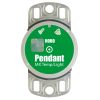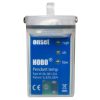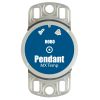Onset HOBO Pendant Temp/Light Logger
Features
- Low-cost temperature with light intensity
- Waterproof housing for wet or underwater use
- Data readout in less than 30 seconds via fast Optic USB interface
- Expedited repair and warranty service
- Lifetime technical support
- More
Overview
The Onset HOBO Pendant Temp/Light data logger is a miniature, waterproof two-channel temperature and relative light level data logger. The logger is suitable for indoor, outdoor, and underwater applications.
Add-Ons
Use a solar radiation shield for accurate temperature measurement in sunlight. See RS1 Solar Radiation Shield (assembly required) and M-RSA (pre-assembled) Solar Radiation Shield. Note that using a solar radiation shield prevents the use of the light sensor.
Measurement Range
Temperature: -20° to 70°C (-4° to 158°F)
Light: 0 to 320,000 lux (0 to 30,000 lumens/ft2)
Accuracy
Temperature: ± 0.53°C from 0° to 50°C (± 0.95°F from 32° to 122°F), see Plot A in manual
Light intensity: Designed for measurement of relative light levels, see Plot D in manual for light wavelength response
Resolution
Temperature: 0.14°C at 25°C (0.25°F at 77°F), see Plot A in manual
Drift: Less than 0.1°C/year (0.2°F/year)
Response Time
Airflow of 2 m/s (4.4 mph): 10 minutes, typical to 90%
Water: 5 minutes, typical to 90%
Time accuracy: ± 1 minute per month at 25°C (77°F), see Plot B in manual
Operating Range
In water/ice: -20° to 50°C (-4° to 122°F)
In air: -20° to 70°C (-4° to 158°F)
Water depth rating: 30 m from -20° to 20°C (100 ft from -4° to 68°F), see Plot C in manual
NIST traceable certification: Available for temperature only at additional charge; temperature range -20° to 70°C (-4° to 158°F)
Battery life: 1 year typical use
Battery Type: CR2032
Memory
UA-002-64: 64K bytes (approximately 28K combined temperature and light readings or events)
Materials: Polypropylene case; stainless steel screws; Buna-N o-ring
Weight: 18 g (0.6 oz)
Dimensions: 58 x 33 x 23 mm (2.3 x 1.3 x 0.9 inches)
Environmental Rating: IP68
In The News
Regional Lake Monitoring in Maine: Community Funded Research and Protection
Lakes everywhere are threatened by climate change, harmful algal blooms , invasive species, and other environmental stressors. Local, regional, and federal agencies have stepped up in order to defend the environment and water resources. The Lakes Environmental Association (LEA) in Maine is one example of an organization dedicated to protecting local freshwater resources. Dr. Ben Peierls, LEA Research Director, explains the history of the nonprofit, "For more than 50 years, [LEA] has been working locally, statewide, and regionally, helping or interacting with people on lake water quality, watershed protection, conservation, education, invasive species, and other issues.
Read MoreSave our Bogs! Culture, Conservation and Climate Action in Ireland’s Peatlands
Characterized by long-term accumulation under waterlogged conditions, peatlands exist on every continent and account for 3-4% of the global land surface . Small but mighty, these often overlooked wetland environments are estimated to hold as much as one-third of the world's organic carbon in their soil—twice the amount found in the entirety of the Earth's forest biomass. While healthy peatlands can trap and store carbon, regulate water, and provide important habitats for rare species, human alteration has disturbed peatland carbon and nitrogen cycles on a global scale. Approximately 12% of the world’s peatlands have been drained and degraded through conversion for agriculture, forestry, infrastructure development, and other uses.
Read MoreSargassum Surge: How Seaweed is Transforming our Oceans and Coastal Ecosystems
Until recently, Sargassum –a free-floating seaweed–was distributed throughout the Sargasso Sea , the north Caribbean Sea, and the Gulf of Mexico. But in the space of a decade, this seaweed has, as one scientist remarks , “Gone from a nonfactor to the source of a terrible crisis.” Driven by climate change, anomalous North Atlantic Oscillation in 2009-2010 and a glut of anthropogenic pollutants, sargassum has proliferated. Seasonally recurrent mats as deep as 7m now bloom in the “Great Atlantic Sargassum Belt” (GASB), which covers areas of the Atlantic from West Africa to the Caribbean Sea and Gulf of Mexico. Every year, millions of tons wash up along the shores of more than 30 countries . Dr.
Read More
















